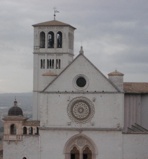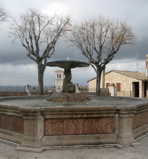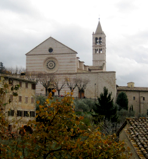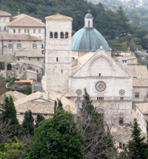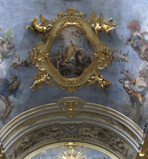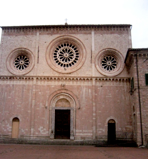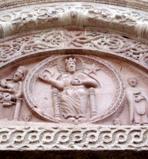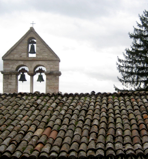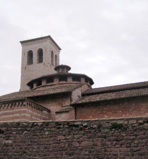the churches of assisi
assisi
Umbria, Italy
Europe
November 20-22, 2008


the churches of assisi
assisi
Umbria, Italy
Europe
November 20-22, 2008


The churches are the main event here and we were so happy to be in the serene energy of these holy places which lend a devotional calm to the entire hill. There are many pilgrims, nuns, and brothers visible about town, many wearing the clothing of the church. The churches with the most beautiful and historical frescoes did not allow photography. Most all the churches we visited had extraordinary features. Here is a brief list:
•Santa Maria Maggiore: a simple Romanesque church. It had a crypt where the first church in Assisi was located, below ground. Original vaulting, columns, Roman ruins were evident here.
•Basilica di Santa Chiara: The basilica is built between 1255-65 in the Italian Gothic style, according to the design by the architect Filippo de Campello. The flying buttresses, added to increase the stability of the church, add interest and balance. The basilica was built in honor of Saint Claire, who left her wealthy family, inspired by St. Francis. She founded the order of “Poor Clares”, an order of nuns, still active today. Giotto’s many frescoes in the nave of the church depict scenes from her life. Two distinctive ones that stand out in my memory include a fresco of Brother Francis cutting her hair, as his order of monks look on; and another, of her family trying to drag her away from the church as she holds onto the altar. The crypt in this church was absolutely magnificent. It held her remains in a sarcophagus, a dressed mannequin of plasterwork tops this memorial, which is enshrined in a circular room. Beautiful black and white patterned stonework embellishes the gothic arches, which are intricately layered with carved stone patterns. The floors are in rust colored and white marble. One area, where her handmade garments, and those of other saintly monks are displayed behind glass, has a most amazing floor. The same colored marble (rust and white) are patterned and inlaid in such a way, that a transparency is effected, which causes the floor to appear to levitate.
•Duomo of San Ruffino: The first church built on this site was begun in 1140, designed by the architect Giovanni di Gubbio. The current duomo was rebuilt in 1571. Below ground is an extraordinary museum which shows Roman ruins, early frescoes (with symbols of Matthew, Mark, Luke, and John in animal form: angel, lion, bull, and eagle, respectively. An early lintel carving in white marble depicts a beautifully carved dog, two dophins and a cup. There is an early Roman sarcophagus, and many columns, some with 2nd century ionic capitals and others with plain leaves dating from the 14th and 15th centuries.
•Santa Maria Sopra Minerva or Saint Mary over Minerva: This is a beautifully scaled, small church in the baroque style built within the 1st century Roman temple dedicated to the goddess Minerva. The six corinthian columns and the portico are from antiquity. The steps leading to the vestibule, fitted into the plinths of the columns are an unusual feature. The interior is beautifully painted with baroque styled frescoes framed in gold on blue walls.
•Chiesa San Stefano: This is a small Romanesque church with a simple bell tower, wooden beamed ceiling and a cross painted off-centered on the wall behind the altar. Remants of early frescoes are still in evidence on the wall. It fronts a small piazza by the same name, which is many steps down from the center of the city.
•Basilica San Francesco: 2 churches rest one on top of the other, on a series of immense arches, an imposing sight when approaching Assisi. The first, Basilica Inferiore, or lower church, was built between 1228-30; the Basilica Superiore, or upper church was begun immediately thereafter with construction spanning the years between 1230-1253. The crypt, dug in 1818, houses the remains of St. Francis. What is amazing about this church is the interior decorations, painted by the leading artists of the 13th and 14th centuries: Cimambue, Giotto, the Lorenzetti brothers and Simone Martini. The Upper Basilica has an undivided nave with frescoes by Giotto, 28 scenes painted to illustrate the life of St. Francis. The Lower Basilica contains beautiful frescoes covering the walls, vaults and chapels by by Simone Martini, Lorenzetti and his pupils, Maso and other pupils of Giotto. Giotto, pupil of Cimambue, took realistic painting to new emotion dimensions, further explored during the Italian Renaissance. One of his frescoes, depicting the life of St. Francis, shows St. Francis, having taken the vow of poverty and chastity, wrapped in a simple cloth, sending his clothes to his family, while hiding behind the bishop to protect himself from his own father. The basilica is immense, and the paintings define the space, with beautiful blues dominating and creating not only a rhythm, but a beautiful and peaceful ambience.
•Abbazia San Pietro: This is a simple abbey of Romanesque architecture, unadorned inside and outside. It is a place for prayer and contemplation.
PHOTOS: Left to right on each horizontal row.
Top Row: 1. Basilica di Santa Chiara as seen from above. 2. Stone detailing as seen through the buttress arches. 3. Fountain in Piazza Santa Chiara. 4. View of Basilica di Santa Chiara.
Second Row: 1. Interior, crypt: Santa Maria Maggiore. 2. Chapel altar and frescoes, Santa Maria Maggiore. 3. Cathedral of San Ruffino. 4. Entrance detail: Cathedral of San Ruffino.
Third Row: 1. Church of Santa Maria Sopra Minerva, (St. Mary above Miinerva) also known as Tiempo di Minerva. 2. Church interior, altar. 3. Santa Maria Sopra Minerva, ceiling. 4. Roof and bell tower of a small, simple Romanesque church, Chiesa San Stefano.
Bottom Row: 1. Basilica San Francesco, viewed on an approached from above. 2. Basilica San Francesco, viewed from the piazza of the lower church. 3. Abbazia San Pietro, façade. 4. Abbazia San Pietro as viewed from the lateral wall.

An Enclave of Prayer







